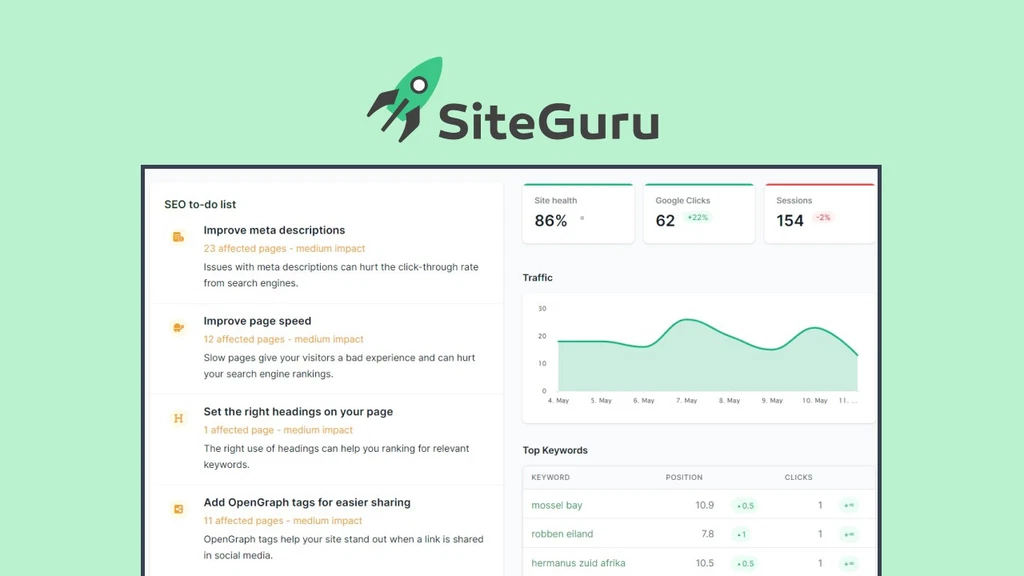

You might see fonts as just visuals. They impact SEO more than you think. SiteGuru knows websites need great design. It is a tuned machine for users and crawlers.
This guide shows how fonts impact SEO. Learn to use typography to rank higher.
Google does not rank sites only on fonts. Typography impacts key SEO factors.
User Experience (UX):
Readability: Easy fonts keep users on your site. It lowers bounce rates and boosts page views. Google sees these as good signs.
Engagement: Good fonts match your brand. They keep users engaged. They explore your content.
Accessibility: Good fonts have high contrast. Use sizes that work for all users. This improves user experience.
Mobile Friendliness:
Responsiveness: Fonts must adapt to all screens. Use fonts for mobile to avoid issues.
Loading Speed: Big font files slow down your site. This hurts your PageSpeed Insights score. It can lower your rankings.
On-Page SEO:
Heading Hierarchy: Use correct font styles for headings. It helps structure content. Search engines see this as important.
Keyword Emphasis: Bold or italicize keywords. Choose fonts that keep readability.
Here are SiteGuru tips for font choices. They will boost your SEO.
Prioritize Readability:
Use clean fonts. They are easy to read on all devices.
Use common fonts. These fonts avoid rendering issues.
Pick fonts with a high x-height. It improves text legibility.
Consider Your Brand Identity:
Select fonts that match your brand’s tone.
Choose one font for headings. Pick another for body text. This makes visual hierarchy and brand consistency.
Limit fonts to 2-3 per site. Avoid visual clutter and keep a nice look.
Optimize for Mobile:
Use responsive font sizes. They adjust to different screens.
Test fonts on mobile devices. Check readability and avoid overlap.
Pick fonts made for mobile viewing.
Optimize for Speed:
Use web-safe fonts. Or, load fonts from a CDN like Google Fonts. It improves loading speed.
Watch font file sizes. Use optimized versions when you can.
Use font-display to manage font loading. It stops flash of invisible text (FOIT). It also stops flash of unstyled text (FOUT).
Ensure Accessibility:
Choose fonts with high contrast. Meet WCAG guidelines.
Use good font sizes. Body text should be 16px or more. Let users adjust font sizes.
Consider users with dyslexia. Some fonts work better for them.

Popular Font Choices for SEO:
Here are font families good for SEO. They have good readability and performance.
| Font Type | Examples |
| Sans-serif | Arial, Helvetica, Open Sans |
| Serif | Times New Roman, Georgia |
Typography is important for branding in ecommerce. It helps create a brand identity.
Brand Recognition: Consistent fonts across your website and marketing make your brand recognizable.
Customer Trust: Professional fonts build trust with customers. They show you care about quality.
Visual Appeal: Good fonts make your site look attractive. It keeps customers browsing longer.
Here are key SEO strategies.
Keyword Integration: Use keywords in headings. It helps search engines understand your content.
Mobile-First Design: Ensure your fonts look good on mobile. Google uses a mobile-first index.
Structured Data: Use schema markup to help search engines understand your typography.
Use Proper Heading Tags (H1-H6): Structure your content logically with heading tags. H1 is for the main title. H2 is for major sections.
Optimize Font Size and Line Height: Adjust font size and line height to improve readability.
Use Whitespace Effectively: Put whitespace around text. It prevents crowding and improves flow.
Consider Kerning and Letter Spacing: Check kerning (space between letters). Ensure consistent readability.
Test, Test, Test: Test your site’s typography on different devices. Make sure it looks good. Use tools like SiteGuru to check your site’s performance.
Font size is a key part of typography. It affects readability and user experience.
Minimum Font Size: Google recommends at least 16px for body text. It makes your site mobile-friendly.
Responsive Font Sizes: Use CSS to adjust font sizes for different screens. It ensures readability on all devices.
Heading Sizes: Use different sizes for headings (H1-H6). It creates a clear hierarchy.
Here is a table about font sizes:
| Heading | Recommended Font Size |
| H1 | 32px – 40px |
| H2 | 24px – 32px |
| Body | 16px – 18px |
Mobile SEO is important. Most users browse on mobile.
Readability: Ensure your fonts are easy to read on small screens.
Touch Targets: Make sure links and buttons are easy to tap on mobile.
Page Speed: Optimize font files to improve mobile page speed.
Typography is part of digital marketing. It affects how users see your brand.
Brand Consistency: Use the same fonts across all marketing materials.
Visual Hierarchy: Use typography to guide users to important information.
Call to Action: Use bold fonts to highlight calls to action.
SiteGuru’s SEO Academy has resources about font optimization. Learn how to improve your site’s typography.
Guides: Read guides on choosing the right fonts.
Tutorials: Watch tutorials on optimizing font sizes.
Best Practices: Follow best practices for typography and SEO.

Good typography helps web crawlers. It makes your site easier to index.
Clear Structure: Use heading tags to show structure.
Readable Text: Ensure your text is easy to read. Crawlers can understand it better.
Mobile-Friendly: Mobile-friendly sites get crawled more often.
Optimize font loading for better page speed.
Web-Safe Fonts: Use web-safe fonts to avoid loading issues.
CDN: Use a CDN to load fonts faster.
Font-Display: Use font-display to control how fonts load.
Keywords affect font selection. Choose fonts that highlight important terms.
Highlight Keywords: Use bold or italics to highlight keywords.
Semantic SEO: Use related terms to support your keywords.
User Intent: Choose fonts that match user intent.
Typography affects link building.
Anchor Texts: Use clear anchor texts with readable fonts.
Internal Links: Use internal links to guide users.
User Experience: Good typography makes users stay longer.
Use marketing software to analyze your typography.
SiteGuru: SiteGuru checks your site’s typography.
Google Analytics: Google Analytics tracks user behavior.
PageSpeed Insights: PageSpeed Insights checks your site’s speed.
Fonts impact user experience, mobile friendliness, and on-page SEO. These things affect a website’s SEO.
Choose fonts that are readable, good looking, mobile-optimized, and accessible. It makes a website that looks great and ranks higher.
Let SiteGuru help you check your website’s typography and SEO. Our platform has insights and tips. Optimize your site for users and search engines. Start your free trial today!
The best font size is 16px to 18px for body text. Headings should be larger.
Ensure body text is readable. Use a clear hierarchy for headings.
Line height should be 1.5x the font size. It improves readability.
12pt to 14pt is professional for print. 16px to 18px is good for web.
Google uses Roboto. It is clean and readable.
Use responsive font sizes. They adjust to different screens.
Arial, Helvetica, and Times New Roman are professional. They are safe choices.
Discover thesaasifyhub.com, where we specialize in reviewing essential SaaS products like GetResponse and FreshBooks. Our mission is to assist you in finding the best digital tools to streamline your operations and drive growth. Let’s explore together!
Welcome to thesaasifyhub.com – where SaaS meets simplicity. Our journey began with a simple mission: to make the world of SaaS accessible, understandable, and beneficial to everyone. We dive into products like GetResponse, QuickBooks, FreshBooks, CuraDebt, and AppSumo, cutting through the noise to deliver honest, insightful reviews.
© 2024 TheSaasifyhub, All right reserved.